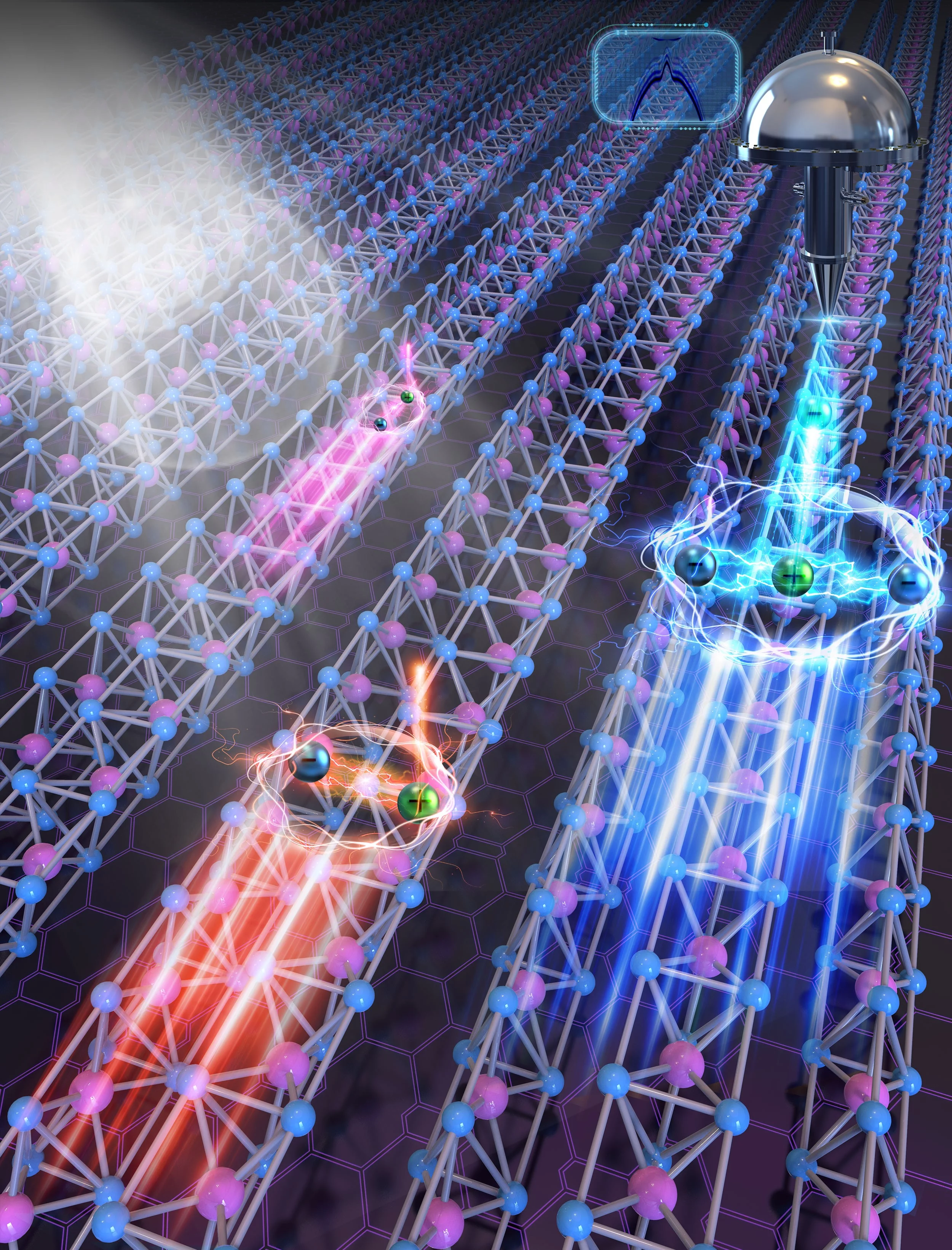Excited about excitons? You should be. As charge neutral and thus efficient data transmitters, these quasiparticles could revolutionise electronics - but only if they can move. Now, for the first time, an international collaboration led by PSI have created and detected dispersing excitons in a metal using angle-resolved photoemission spectroscopy. They publish their observations in the journal Nature Materials.
Excitons are temporary bound states between electrons and positively charged holes, created when an electron absorbs a photon and moves to an excited state, leaving behind a hole in the valence band. Mobile excitons, due to their charge neutrality, offer great promise as a means for transmitting information without losses resulting from interactions with other charges en route. In contrast, the numerous interactions of electrons lead to resistance, heating and limitations in computational efficiency. Yet, the phenomenon of mobile excitons in metals has until now remained elusive, with traditional optical experiments only creating and detecting excitons with negligible momentum. Now, researchers at the Swiss Light Source have observed dispersing excitons with large momentum for the first time in the transition metal trichalcogenide, TaSe3.
Transition metal trichalcogenides
The trichalcogenides are an interesting family of materials. A type of van der Waals material, these metals are made up of covalently bonded two-dimensional planes held weakly together by van der Waals forces. Each layer of the material is formed from chains, which lie parallel to each other like train tracks. Thus, the material can be considered a quasi-one-dimensional metal.
Typically, transition metal trichalcogenides become insulating at low temperatures; they undergo structural deformation and a band gap opens up, rendering the electrons immobile. Yet one trichalcogenide, TaSe3, is unusual in that it becomes superconducting below 2 degrees Kelvin without forming an insulating charge density wave. Aiming to understand the peculiar properties and topology of TaSe3 using angle-resolved photoemission spectroscopy (ARPES) at the SLS, which enables detailed mapping of electronic band structures, researchers from the Spectroscopy of Novel Materials Group made a fortuitous and unexpected discovery.
The mystery of the side valence bands
Whilst probing TaSe3 with ARPES, a technique that enables unique insight into the dispersive nature of materials through energy and momenta data of photoemitted electrons, researchers noticed some unusual features. In the ARPES spectra, as well as the main valence band resulting from single electron excitation predicted by band structure theory, were faint side valence bands: evidence of other, unexplained electronic excitations in the material.
Sidebands are typically observed in ARPES when incoming photons knock out electrons at the same time as exciting another mode, such as a phonon or lattice vibration. However, as these secondary excitations are costly energy-wise, such sidebands appear below the main valence band in the spectrum. The researchers were foxed: their sidebands appeared above the main valence band.
“The fact that we saw something above was very mysterious,” explains corresponding author Ming Shi, who led the study. The scientists hypothesised on the physical explanation for these mysterious side bands. “At first, we wondered if it could be a periodic oscillation in the material triggered by the impact of the photon, but this would result in side bands both above and below the main valence band, so we ruled this out,” he continues.
Solving this riddle required systematic theoretical reasoning and model building – and a forgotten hypothesis described in a paper from over half a century ago.
“The fact that these bands appeared at a lower binding energy than the main excitation suggested to us that some extra relaxation takes place as you hit out the electron. And then we developed the theory that we were observing a multiparticle excitation, consisting of a moving exciton plus an additional hole in a different area of the electronic structure - the conduction band,” says Markus Müller who developed the theoretical interpretation of these observations in the Condensed Matter Theory group.
Due to the shape of the bands, it appeared that excitons were being created with finite momentum and dispersing along the length of the chains in the material. If their theory was correct, they were observing mobile excitons for the first time in a metal.
“This was an almost unheard of idea. But then, we encountered a theoretical paper from the mid-1960s about a quite different 1D system, and realised that the ideas from this paper could apply to this material,” explains Christopher Mudry, head of the Condensed Matter Theory group.
To test their theory, the researchers then considered how the side valence bands should behave under controlled surface doping to change the number of electrons in the material. The results were consistent with the theory: the energy separation between side and main valence bands changed correspondingly. The theory was also able to explain the possible origin of the various side valence bands, resulting from distinct internal structures of the excitons: interchain excitons, intrachain excitons or trions (consisting of two conduction electrons and a hole).
Special properties of TaSe3
What makes these excitons so exciting? Firstly, their mobility.
“Such bound states have been known for a long time, but usually they are only created at zero momentum. Here, what is new is that we first find such bound states that are moving with a finite velocity, meaning that, in principle they could transport information,” explains Ming Shi.
The second unusual feature of these excitons is that they occur not in an insulator, but in a metal. Typically, in metals, screening by the numerous conduction electrons lowers the interaction energy, preventing the formation of the bound state.
“With hindsight, we now understand what makes TaSe3 unique is a combination of several key features that favour the hitherto elusive formation and detection of mobile excitons in a metal,” continues Ming Shi.
In TaSe3, three favourable attributes promote mobile excitons. Firstly, despite being a metal, the density of conduction electrons is low and the screening is poor. Secondly, the low dimensionality in TaSe3 further reduces screening. Combine this with a third feature of heavy quasiparticles (polarons), which promotes exciton formation, and you have the ingredients for mobile excitons in a metal.
Knowing these special ingredients will enable more guided research to discover other low dimensional metals that may be able to host mobile excitons, and looking to the future, to develop their huge potential as neutral information carriers. “When you know where to look, discovering this effect in other materials suddenly becomes a lot easier,” Ming Shi adds.
Text: Paul Scherrer Institute / Miriam Arrell
© PSI provides image and/or video material free of charge for media coverage of the content of the above text. Use of this material for other purposes is not permitted. This also includes the transfer of the image and video material into databases as well as sale by third parties.
Contact
Dr. Ming Shi
Senior Scientist
Spectroscopy of Novel Materials group
Paul Scherrer Institute
Forschungsstrasse 111
5232 Villigen PSI
Switzerland
Telephone: +41 56 310 23 93
Email: ming.shi@psi.ch
Original Publication
Multiple mobile excitons manifested as sidebands in quasi-one-dimensional metallic TaSe3
J. Ma, S. Nie, X. Gui, M. Naamneh, J. Jandke, C. Xi, J. Zhang , T. Shang , Y. Xiong, I. Kapon, N. Kumar, Y.Soh, D. Gosálbez-Martínez, O. V. Yazyev, W. Fan, H. Hübener, U. De Giovannini, N. Clark Plumb, M. Radovic, M. A. Sentef, W. Xie, Z. Wang, C. Mudry, M. Müller and M. Shi
Nature Materials (2022)
Further Information
Spectroscopy of Quantum Materials Group | SPECNOVMAT Group | Paul Scherrer Institut (PSI)
Condensed Matter Theory Group | LTC | Paul Scherrer Institut (PSI)
Funding
This work was supported by the Swiss National Science Foundation and the National Centre of Competence in Research (NCCR) MARVEL.

